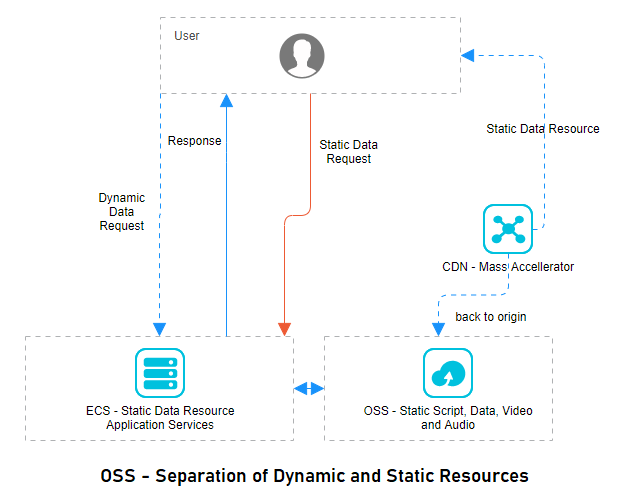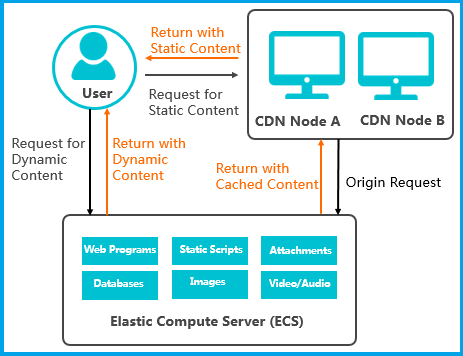By Shantanu Kaushik
Our Internet presence is driven by content, and in most things we do online, such as reading news, buying products, and browsing through social media, we use a content delivery network (CDN). Even when you are watching a video online or trying to access a knowledge base, such as an encyclopedia, it uses a content delivery network to present the required resources.
CDNs are responsible for almost event bit of content you see on your computer, tablet, or smartphone. Content delivery networks are the backbone of content delivery. In this article, we will use Alibaba Cloud CDN and provide best practices using Object Storage Service (OSS) and Elastic Compute Service (ECS).
Content delivery networks (CDN) are known for solving latency issues to enable smoother and available content delivery. The moment you request some content by opening a webpage until the moment the content is displayed on your screen is the total amount of time to present the requested content. This is the time that is accelerated to provide faster content delivery to users.
Alibaba Cloud Content Delivery Network (CDN) can accelerate the delivery of static resources from an Object Storage Service (OSS) instance. Object Storage Service is built for large data operations related to storage and delivery. Alibaba Cloud OSS works with API Gateway to enable API operations. It can be implemented using the OSS console and SDKs. Objects have been well defined within the OSS framework to support different types of storage needs.
Alibaba Cloud OSS defines buckets that are the containers used to store data within the Object Storage Service. Every object within Alibaba Cloud OSS is stored in a bucket and allows the user to assign different attributes to different objects. You can create numerous types of buckets to store data and classify them according to storage class and requirements.

Alibaba Cloud CDN works with a concept that redirects any user requests for static resources to CDN nodes nearest to the clients, enabling efficient retrieval of the requested content. This smart system ensures minimum network congestion. Static resources stored using Alibaba Cloud OSS may include scripts, images, attachments, audio files, and video files. Let’s take a look at the architectural flow associated with Alibaba Cloud Object Storage Service (OSS) with the delivery of static and dynamic data on the chart below:

In this scenario, Object Storage Service behaves like the origin server. The delivery of content stored in OSS is accelerated by Alibaba Cloud CDN and the users are presented with the files or data from the nearest CDN nodes.
Scenario Highlights:
Alibaba Cloud Content Delivery Network (CDN) can cache static resources stored on Elastic Compute Service (ECS) instances to accelerate the resource delivery. However, ECS instances can store static and dynamic resources that can be used with Dynamic Route for Content Delivery Network (DCDN) on Alibaba Cloud.
When a user sends out a request for dynamic content from an ECS instance, the ECS instance returns the requested resources to the user using DCDN. Similarly, when a user requests static resources from an ECS instance, the CDN node nearest to the user will send out the requested content without pinging the ECS instance. This enables accelerated content delivery for static and dynamic content using Alibaba Cloud CDN. This creates an overlay in terms of continuous content delivery without any interruptions.

An ECS instance can store dynamic resources, such as web applications and databases, and static resources, such as scripts, images, attachments, audio files, and video files. CDN nodes cache static resources rather than dynamic resources from the ECS instance. When a user sends out a request for any dynamic content, the ECS instance returns the requested content to the user. In this scenario, the ECS instance will behave as the origin server and deliver the requested content.
Solution Highlights:
Alibaba Cloud CDN can take away a lot of unnecessary complexities related to content delivery. Alibaba Cloud covers requirements for added security and static or dynamic content. When it comes to accelerating delivery using the cloud storage or ECS instance, Alibaba Cloud CDN can provide an edge while doing so.
There are a variety of situations where you can use, customize, and optimize content delivery using Alibaba Cloud CDN. Many organizations and industries already use Alibaba Cloud CDN, and you can start your journey today.

2,599 posts | 764 followers
FollowAlibaba Clouder - April 20, 2021
Alibaba Clouder - July 29, 2020
Alibaba Clouder - March 19, 2021
Alibaba Clouder - November 9, 2020
Alibaba Clouder - February 26, 2021
Alibaba Clouder - January 18, 2021

2,599 posts | 764 followers
Follow Server Load Balancer
Server Load Balancer
Respond to sudden traffic spikes and minimize response time with Server Load Balancer
Learn More API Gateway
API Gateway
API Gateway provides you with high-performance and high-availability API hosting services to deploy and release your APIs on Alibaba Cloud products.
Learn More Best Practices
Best Practices
Follow our step-by-step best practices guides to build your own business case.
Learn More Accelerated Global Networking Solution for Distance Learning
Accelerated Global Networking Solution for Distance Learning
Alibaba Cloud offers an accelerated global networking solution that makes distance learning just the same as in-class teaching.
Learn MoreMore Posts by Alibaba Clouder